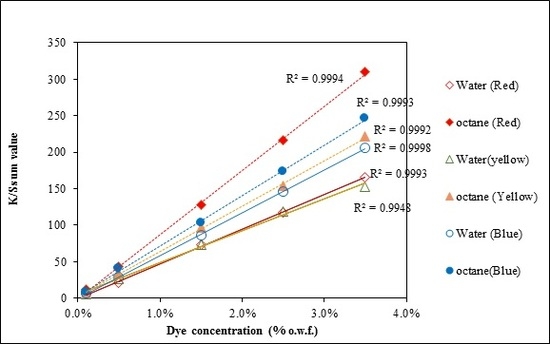Octane-Assisted Reverse Micellar Dyeing of Cotton with Reactive Dyes
Abstract
:1. Introduction
2. Experimental Details
2.1. Materials and Reagents
2.2. Pre-Cleaning of Cotton Fabric
2.3. Dyeing Cotton in Water
2.4. Dyeing Cotton with the Reverse Micellar System
2.5. Establishment of Calibration Curves
2.6. Simulated Dyeing for Computer Colour Matching
2.7. Predicting Dye Recipe
2.8. Colour Difference
3. Results and Discussion
3.1. Reflectance Values of the Dyed Samples
3.2. Linearity of the Calibration Curves
3.3. Computer Colour Matching (CCM)
3.4. Colour Difference
4. Conclusions
Acknowledgments
Author Contributions
Conflicts of Interest
References
- Dong, Y.; Chen, J.; Li, C.; Zhu, H. Decoloration of three azo dyes in water by photocatalysis of Fe (III)–oxalate complexes/H2O2 in the presence of inorganic salts. Dyes Pigment. 2007, 73, 261–268. [Google Scholar] [CrossRef]
- Hickman, W.S. Environmental aspects of textile processing. J. Soc. Dyers Colour. 1993, 109, 32–37. [Google Scholar] [CrossRef]
- Perkins, W.S. Textile Coloration and Finishing; Carolina Academic Press: Durham, NC, USA, 1996. [Google Scholar]
- Srikulkit, K.; Santifuengkul, P. Salt-free dyeing of cotton cellulose with a model cationic reactive dye. Color. Technol. 2000, 116, 398–402. [Google Scholar] [CrossRef]
- Pisuntornsug, C.; Yanumet, N.; O’Rear, E.A. Surface modification to improve dyeing of cotton fabric with a cationic dye. Color. Technol. 2002, 118, 64–68. [Google Scholar] [CrossRef]
- Zhang, F.; Chen, Y.; Lin, H.; Lu, Y. Synthesis of an amino-terminated hyperbranched polymer and its application in reactive dyeing on cotton as a salt-free dyeing auxiliary. Color. Technol. 2007, 123, 351–357. [Google Scholar] [CrossRef]
- Bechtold, T.; Mussak, R.; Mahmud-Ali, A.; Ganglberger, E.; Geissler, S. Extraction of natural dyes for textile dyeing from coloured plant wastes released from the food and beverage industry. J. Sci. Food Agr. 2006, 86, 233–242. [Google Scholar] [CrossRef]
- Vankar, P.S.; Shanker, R.; Mahanta, D.; Tiwari, S. Ecofriendly sonicator dyeing of cotton with Rubia cordifolia Linn. using biomordant. Dyes Pigment. 2008, 76, 207–212. [Google Scholar] [CrossRef]
- Mirjalili, M.; Nazarpoor, K.; Karimi, L. Eco-friendly dyeing of wool using natural dye from weld as co-partner with synthetic dye. J. Clean. Prod. 2011, 19, 1045–1051. [Google Scholar] [CrossRef]
- Lu, X.; Liu, L.; Liu, R.; Chen, J. Textile wastewater reuse as an alternative water source for dyeing and finishing processes: A case study. Desalination 2010, 258, 229–232. [Google Scholar] [CrossRef]
- Sawada, K.; Ueda, M. Adsorption behavior of direct dye on cotton in non-aqueous media. Dyes Pigment. 2003, 58, 37–40. [Google Scholar] [CrossRef]
- Jun, J.; Sawada, K.; Takagi, T.; Kim, G.; Park, C.; Ueda, M. Effects of pressure and temperature on dyeing acrylic fibres with basic dyes in supercritical carbon dioxide. Color. Technol. 2005, 121, 25–28. [Google Scholar] [CrossRef]
- Hou, A.; Chen, B.; Dai, J.; Zhang, K. Using supercritical carbon dioxide as solvent to replace water in polyethylene terephthalate (PET) fabric dyeing procedures. J. Clean. Prod. 2010, 18, 1009–1014. [Google Scholar] [CrossRef]
- Abou Elmaaty, T.; Abd El-Aziz, E.; Ma, J.; El-Taweel, F.; Okubayashi, S. Eco-friendly disperse dyeing and functional finishing of nylon 6 using supercritical carbon dioxide. Fibers 2015, 3, 309–322. [Google Scholar] [CrossRef]
- Zheng, H.; Xu, Y.; Zhang, J.; Xiong, X.; Yan, J.; Zheng, L. An ecofriendly dyeing of wool with supercritical carbon dioxide fluid. J. Clean. Prod. 2017, 143, 269–277. [Google Scholar] [CrossRef]
- Parvinzadeh Gashti, M.; Rashidian, R.; Almasian, A.; Badakhshan Zohouri, A. A novel method for colouration of cotton using clay nano-adsorbent treatment. Pigment Resin Technol. 2013, 42, 175–185. [Google Scholar] [CrossRef]
- Sawada, K.; Ueda, M. Dyeing of protein fiber in a reverse micellar system. Dyes Pigment. 2003, 58, 99–103. [Google Scholar] [CrossRef]
- Wang, Y.; Lee, C.H.; Tang, Y.L.; Kan, C.W. Dyeing cotton in alkane solvent using polyethylene glycol-based reverse micelle as reactive dye carrier. Cellulose 2016, 23, 965–980. [Google Scholar] [CrossRef]
- Luisi, P.L. Enzymes hosted in reverse micelles in hydrocarbon solution. Angew. Chem. Int. Ed. Engl. 1985, 24, 439–450. [Google Scholar] [CrossRef]
- Liu, D.; Ma, J.; Cheng, H.; Zhao, Z. Investigation on the conductivity and microstructure of AOT/non-ionic surfactants/water/n-heptane mixed reverse micelles. Colloids Surf. A 1998, 135, 157–164. [Google Scholar] [CrossRef]
- Yi, S.; Dong, Y.; Li, B.; Ding, Z.; Huang, X.; Xue, L. Adsorption and fixation behaviour of CI Reactive Red 195 on cotton woven fabric in a nonionic surfactant Triton X-100 reverse micelle. Color. Technol. 2012, 128, 306–314. [Google Scholar] [CrossRef]
- Yi, S.; Deng, Y.; Sun, S. Adsorption and dyeing characteristics of reactive dyes onto cotton fiber in nonionic triton x-100 reverse micelles. Fiber Polym. 2014, 15, 2131–2138. [Google Scholar] [CrossRef]
- Yi, S.; Tong, X.; Sun, S.; Dai, F. Dyeing properties of CI reactive violet 2 on cotton fabric in non-ionic TX-100/Span40 mixed reverse micelles. Fiber Polym. 2015, 16, 1663–1670. [Google Scholar] [CrossRef]
- Zhang, B.; Li, H. Research on application for color matching in textile dyeing based on numerical analysis. Comput. Sci. Softw. Eng. Int. Conf. 2008, 1, 357–360. [Google Scholar]
- Cheng, F.; Wang, K.; Chen, G. Study on the application of computer color-measuring and matching technology in fur dyeing. China Leather 2004, 15, 009. [Google Scholar]
- Wang, N.; Yang, L. Application of color matching system in dyeing of cotton. Prog. Text. Sci. Technol. 2007, 2, 26–29. [Google Scholar]
- Xue, C.; Jia, S.; Li, Z. Application of computer color matching system to nylon fabric dyeing. J. Shaanxi Univ. Sci. Technol. 2005, 4, 49–55. [Google Scholar]
- Tang, A.Y.L.; Wang, Y.M.; Lee, C.H.; Kan, C.W. Computer color matching and levelenss of PEG-based reverse micellar decamethylcyclopentasiloxane (D5) solvent-assisted reactive dyeing on cotton fiber. Appl. Sci. 2017, 7, 682. [Google Scholar] [CrossRef]
- Israeli, O. A Shapley-based decomposition of the R-Square of a linear regression. J. Econ. Inequal. 2007, 5, 199–212. [Google Scholar] [CrossRef]


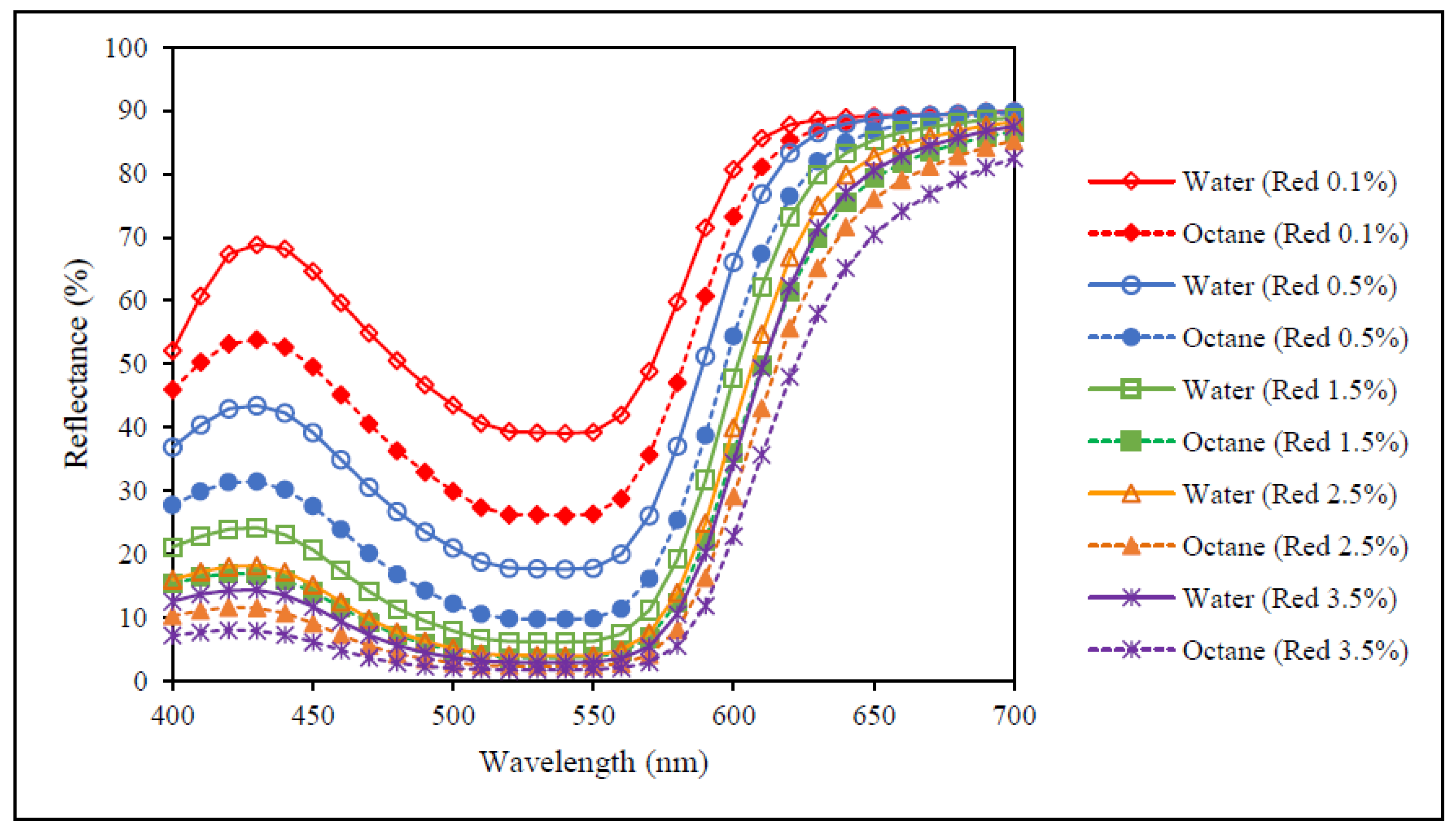

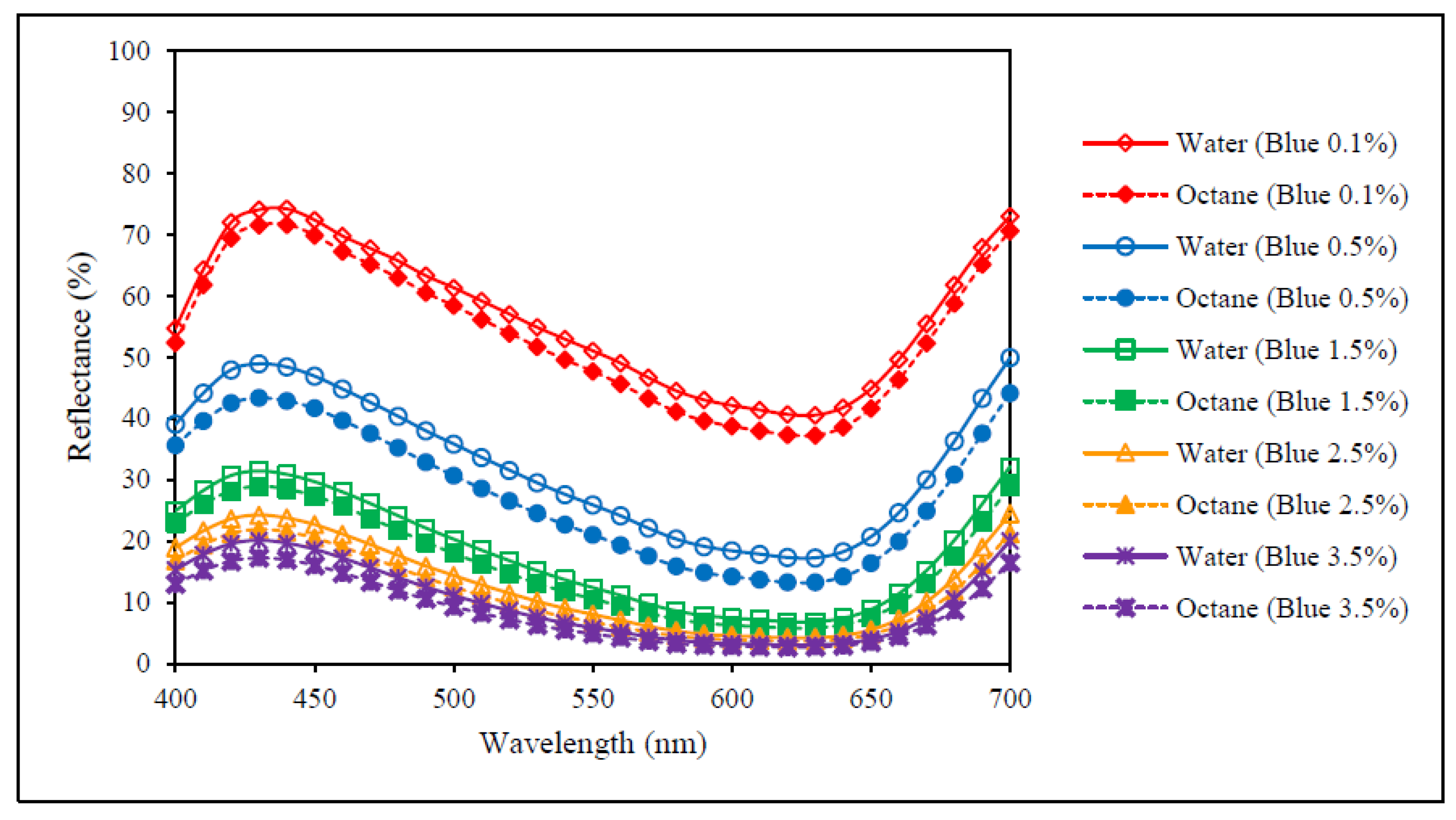
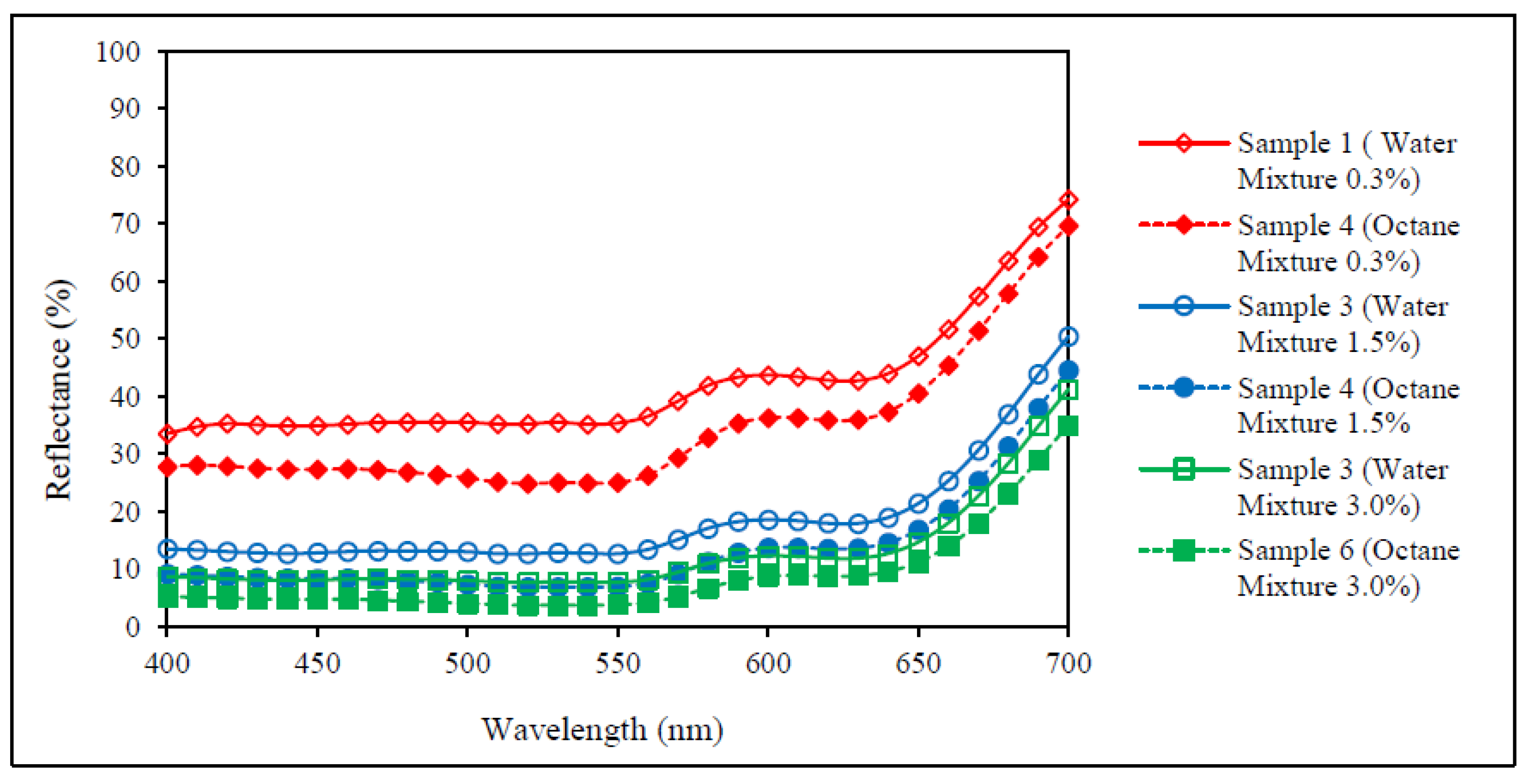

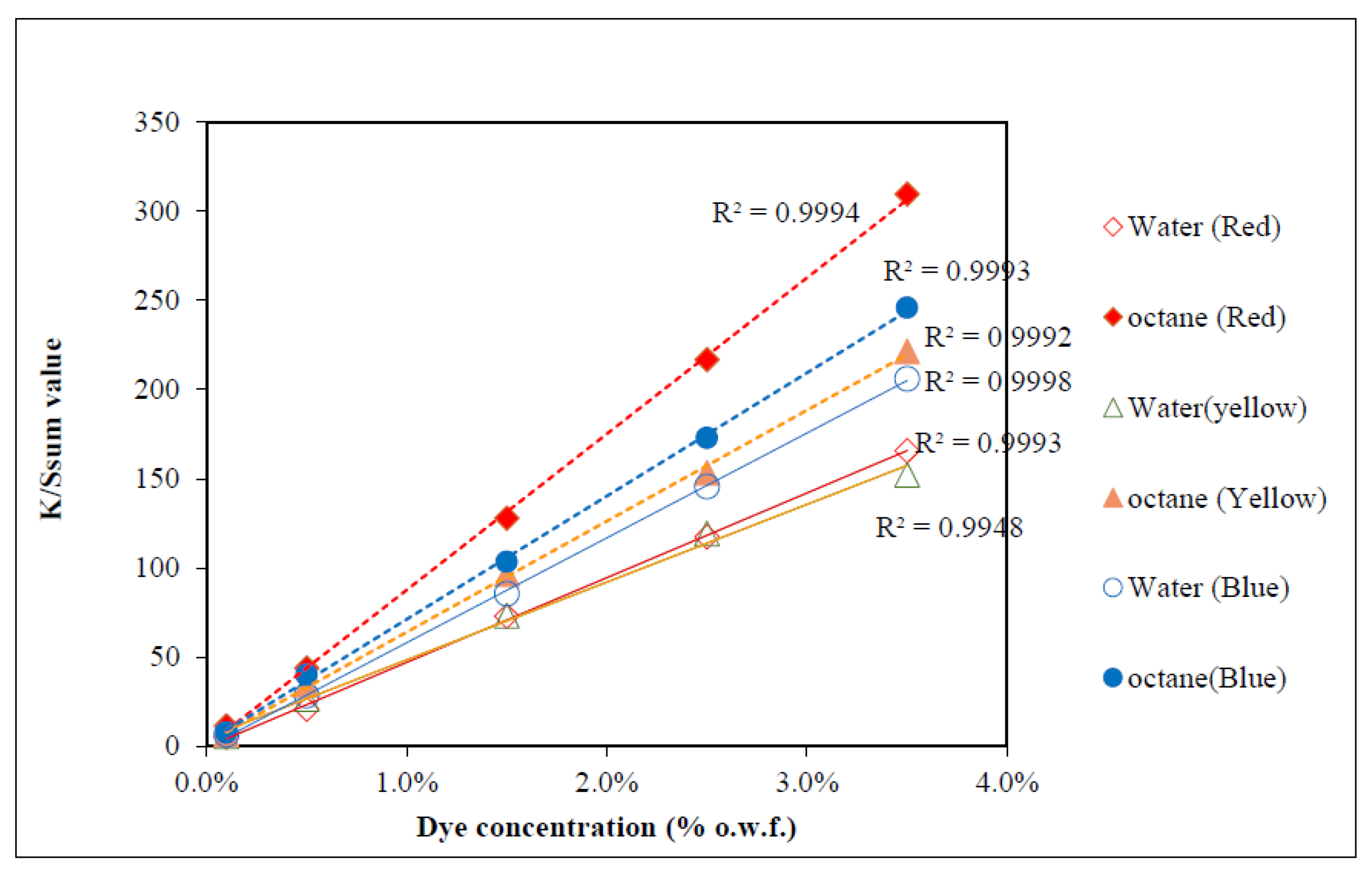
| Characteristics | Water-Based Conventional Dyeing | Reverse Micellar Dyeing |
|---|---|---|
| Color yield | Lower | Higher |
| Electrolyte addition | Yes | No |
| Salt content in effluent | Yes | No |
| Water consumption | Higher | Lower |
| Effluent production | Higher | Lower |
| Effluent treatment cost | Higher | Lower |
| Environmental friendliness | Lower | Higher |
| Recyclability | Lower | Higher |
| Effluent treatment techniques | Complex | Simple |
| Dye Concentration (% owf *) | Additives | |
|---|---|---|
| Salt (NaCl, g/L) | Soda Ash (Na2CO3, g/L) | |
| 0.1 | 10 | 5 |
| 0.5 | 20 | 5 |
| 1.5 | 42.5 | 5 |
| 2.5 | 55 | 5 |
| 3.5 | 65 | 5 |
| Dye Concentration (% owf) | Colour Fixation Agent to Cotton Weight Ratio (g/g) |
|---|---|
| 0.1 | 0.06 |
| 0.5 | 0.06 |
| 1.5 | 0.08 |
| 2.5 | 0.09 |
| 3.5 | 0.09 |
| Dyeing Methods | Sample | Red | Yellow | Blue |
|---|---|---|---|---|
| Conventional water dyeing | Sample 1 (Standard 0.3%) | 0.1 | 0.1 | 0.1 |
| Sample 2 (Standard 1.5%) | 0.5 | 0.5 | 0.5 | |
| Sample 3 (Standard 3.0%) | 1 | 1 | 1 | |
| Reverse micellar dyeing | Sample 4 (Standard 0.3%) | 0.1 | 0.1 | 0.1 |
| Sample 5 (Standard 1.5%) | 0.5 | 0.5 | 0.5 | |
| Sample 6 (Standard 3.0%) | 1 | 1 | 1 |
| Formulae | Colour | Samples | ||
|---|---|---|---|---|
| Sample 1 (0.3%) | Sample 2 (1.5%) | Sample 3 (3%) | ||
| Standard sample (obtained from simulated dyeing) | Yellow | 0.10 | 0.50 | 1.00 |
| Blue | 0.10 | 0.50 | 1.00 | |
| Red | 0.10 | 0.50 | 1.00 | |
| Conventional Water-based Dyeing | Yellow | 0.10 (0.00) | 0.50 (0.00) | 0.88 (−0.12) |
| Blue | 0.09 (−0.01) | 0.44 (−0.06) | 0.76 (−0.24) | |
| Red | 0.08 (−0.02) | 0.44 (−0.06) | 0.83 (−0.17) | |
| Octane-assisted Reverse Micellar Dyeing | Yellow | 0.11 (+0.01) | 0.56 (+0.06) | 1.06 (+ 0.06) |
| Blue | 0.11 (+0.01) | 0.53 (+0.03) | 0.91 (−0.09) | |
| Red | 0.09 (−0.01) | 0.54 (+0.04) | 1.10 (+0.10) | |
| Concentration | Lwater | awater | bwater | Loctane | aoctane | boctane | ΔE |
|---|---|---|---|---|---|---|---|
| 0.3% | 68.17 | 6.42 | 4.02 | 67.72 | 6.42 | 4.50 | 0.66 |
| 1.5% | 45.27 | 8.82 | 4.49 | 45.39 | 8.76 | 4.12 | 0.39 |
| 3.0% | 36.57 | 9.66 | 3.89 | 36.88 | 9.45 | 3.59 | 0.48 |
© 2017 by the authors. Licensee MDPI, Basel, Switzerland. This article is an open access article distributed under the terms and conditions of the Creative Commons Attribution (CC BY) license (http://creativecommons.org/licenses/by/4.0/).
Share and Cite
Tang, A.Y.-l.; Lee, C.-h.; Wang, Y.; Kan, C.-w. Octane-Assisted Reverse Micellar Dyeing of Cotton with Reactive Dyes. Polymers 2017, 9, 678. https://doi.org/10.3390/polym9120678
Tang AY-l, Lee C-h, Wang Y, Kan C-w. Octane-Assisted Reverse Micellar Dyeing of Cotton with Reactive Dyes. Polymers. 2017; 9(12):678. https://doi.org/10.3390/polym9120678
Chicago/Turabian StyleTang, Alan Yiu-lun, Cheng-hao Lee, Yanming Wang, and Chi-wai Kan. 2017. "Octane-Assisted Reverse Micellar Dyeing of Cotton with Reactive Dyes" Polymers 9, no. 12: 678. https://doi.org/10.3390/polym9120678





